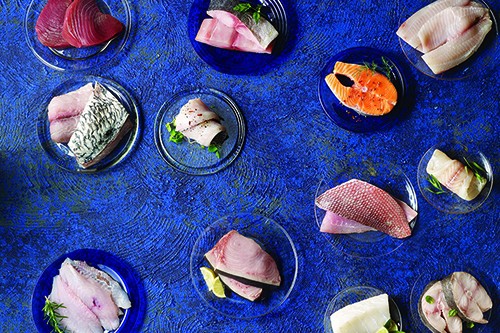
For centuries, seafaring cultures have embraced fish as cuisine. Over the years, research and culinary creativity have shown fish is good choice.
Omega-3 essential fatty acids found in fish — docosahexaenoic acid, or DHA, and eicosapentaenoic acid, or EPA — help the body maintain the flexibility of artery walls, control inflammation and clear arteries, reducing the risk of blood clots.
People who consume adequate amounts of DHA and EPA tend to have reduced risk for heart disease and stroke, improved brain function and memory and a greater ability to control autoimmune diseases. To get the desired benefits, the American Heart Association recommends one 3.5-ounce serving of cooked fish at least twice per week.
How fish come to contain omega-3s is directly related to their diet and lifespan. Algae is eaten by small marine life, which are consumed by slightly larger fish. A fattier, longer-living fish has more opportunities to consume DHA and EPA, and will more omega-3s when eaten by humans.
Larger fish, such as swordfish, also contain more potential toxins such as mercury. Consumers, especially pregnant women and young children, should review the Food and Drug Administration’s safety guidelines for consuming fish from different regions.
Lean protein, the building block of human bones, cartilage, muscle and skin, is especially plentiful in fish. Fatty fish also contains vitamin D, a nutrient that is underconsumed by many Americans.
Culinary approaches to fish vary by region. For example, Puerto Rico marries mild whitefish, tomato, garlic and avocado when creating the popular fish stew Bacalao Guisado. Iceland’s Plokkfiskur is a heartier version that includes potatoes and cream. Japan takes a simple approach by accentuating the quality of raw fish in sashimi.
Some fish species are heavily overfished and considered vulnerable — if not endangered — including halibut, shark, sardines, bluefin tuna, orange roughy and squid. Improving seafood standards and ensuring a sustainable supply chain is key in ensuring future generations can enjoy the nutritious benefits of fish.
Tuna
A member of the mackerel family, tuna is a popular canning fish with a rich flavor and firm, flaky texture. Albacore, skipjack and yellowfin are popular choices for sandwiches, casseroles or salads. Check the Monterey Bay Aquarium’s Seafood Watch website to confirm best choices.
Barramundi
Often used in Australian and Thai cuisine, barramundi’s popularity is growing thanks to its ability to be farmed without antibiotics or hormones. Barramundi has a mild, slightly sweet flavor, making it a suitable replacement for whitefish in recipes.
Bass
A term used for numerous freshwater and saltwater fish, “bass” may include grouper and sunfish. Sea bass tends to be richer in vitamin B6, while freshwater bass has substantially more vitamin B12. Water quality can influence its flavor.
Mahi Mahi
Grilled, fried, baked or broiled, mahi mahi is highly versatile. Use it in tacos, coat it with pesto or mix it into curried vegetables. Look for sources caught in the U.S., as most imported sources are on the Monterey Bay Aquarium Seafood Watch’s “avoid” list.
Lionfish
Rated a “best choice” by the Monterey Bay Aquarium, this fish has aesthetic flair and a buttery bite. Serve it as sashimi or in ceviche with a squeeze of lime. If you have a whole fish, consult a professional to help safely remove its eye-catching, toxic spikes.
Swordfish
Thick slices of swordfish seasoned with olive oil and herbs are ideal for grilling. When buying swordfish steak, look for a reddish swirl in the cross section, which indicates freshness.
Salmon
Flaky, pink salmon is found on menus from high-end restaurants to delis, as fillets or sliced thinly atop a bagel with cream cheese. Smoked salmon is a travel-friendly option. Check the Monterey Bay Aquarium Seafood Watch website for best choices.
Cod
Cod’s mild flavor makes it a recipe chameleon, pairing well with a range of ingredients and sauces. Be mindful of frozen cod, which often is treated with a salt solution to retain moisture. For sustainable sources, choose cod from Alaska.
Sablefish
Its nickname, “butterfish,” says it all. This silky, fatty fish is rich in omega-3s. Best when pan-fried or grilled (the fat content creates a decadent, crispy bite), it also can be eaten raw in sushi.
Tilapia
Mildly sweet tilapia is often served baked, fried, seared or smoked. It pairs well with fruit salsas or tangy salad dressings. Due to a lack of data on environmental impact and potential chemical use, the Monterey Bay Aquarium Seafood Watch recommends avoiding farmed tilapia from Colombia.
Red Snapper
With firm flesh and little fat, red snapper holds up in stews and gives a meaty bite to sandwiches. Opt for snapper caught in the U.S. Gulf of Mexico and avoid those caught in the U.S. South Atlantic.
Pollock
Sometimes confused with cod, pollock has a mild flavor. A 3-ounce serving provides 17 grams of protein, is an excellent source of vitamin B12 and selenium, and is a good source of phosphorus.


